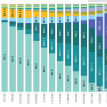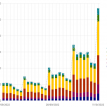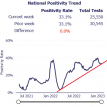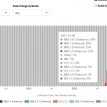
ECDC: Assessment of the XBB.1.5 Kraken variant
The European Centre for Disease Control and Prevention has published a risk assessment for the XBB.1.5 Kraken SARS-CoV-2 variant, which we have republished below.
“XBB.1.5 is a sub-lineage of the SARS-CoV-2 lineage XBB, and is currently estimated to have a large growth advantage over previously circulating lineages in North America (109%) and Europe (113%), although these estimates are associated with significant uncertainty. There is a risk that this variant may have an increasing effect on the number of COVID-19 cases in the EU/EEA, but not within the coming month as the variant is currently only present at very low levels in the EU/EEA.”
More…
XBB.1.5 is a sub-lineage of XBB with an additional spike RBD mutation S486P. This lineage was first detected in United States (US) with the sample collection dates as of 22 October 2022, and since then the lineage has been seen increasing.
As of 9 January 2023, 4 770 sequences have been deposited in GISAID EpiCoV belonging to XBB.1.5 with the mutational profile in Spike region – Q183E, F486P and F490S. Most of these submissions are from the US (4111 sequences), and the United Kingdom (202 sequences), and the variant has also been detected in several other countries, including EU/EEA countries – Austria, Belgium, Czechia, Denmark, France, Germany, Iceland, Ireland, Italy, the Netherlands, Portugal, Romania, Slovenia, Spain, and Sweden. The proportion of the variant in the EU/EEA is lower than 2.5% for the last two weeks of 2022 for all countries where variant proportions at this low level can be accurately estimated.
This lineage is currently estimated to have a large growth advantage relative to previously circulating lineages in North America (109%) and Europe (113%) (estimates provided by CoV-spectrum based on data from GISAID EpiCoV), although these estimates are associated with significant uncertainty.
The US Centers for Disease Prevention and Control (US CDC) reports a doubling time of the proportion of XBB.1.5 of 9 days and the US CDC Nowcast system estimates the current proportion of the variant around 27.6% in the US (95% prediction interval 14.0-46.5%). Due to the uncertainty associated with the estimate, it is still unclear whether the variant will become dominant in the US in the coming few weeks. The rapid growth in the US does not necessarily mean that the variant will become dominant in the EU/EEA, since major differences in variant circulation between North America and Europe have been observed several times during the pandemic.
The most likely explanation of the growth advantage is the already high level of immune escape demonstrated by XBB, combined with the effect of the spike change S486P. This mutation has previously been rare during the pandemic, probably due to it requiring two nucleotide substitutions in the same codon to change from phenylalanine to proline. In fact, other variants with this change have emerged before without becoming successful.
A recent preprint demonstrates that XBB.1.5 is not associated with a higher reduction in neutralisation by vaccinee and convalescent sera compared to XBB.1, but that it is associated with a higher ACE2 affinity, which could indicate that the advantage of XBB.1.5 compared to XBB.1 could be caused by an increase in intrinsic transmissibility.
Further laboratory and epidemiological investigations are required to elucidate the mechanism of the growth advantage conferred by this change for the XBB variant specifically. There is currently not enough information available to assess any change in infection severity associated with the variant.
There is a risk that this variant may have an increasing effect on the number of cases of COVID-19 in the EU/EEA, but not within the coming month as the variant is currently only present at very low levels in the EU/EEA. Due to uncertainties associated with the growth rate of the variant, this assessment is associated with a high degree of uncertainty.
ECDC: Update on SARS-CoV-2 variants: ECDC assessment of the XBB.1.5 sub-lineage
Photo by Denys Nevozhai on Unsplash





